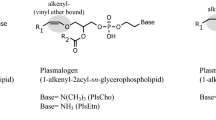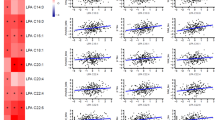Abstract
Fatty acid differences, including docosahexaenoic acid (DHA; 22:6n-3) have been shown in the brains of Alzheimer's patients (AD) as compared with normal age-matched individuals. Furthermore, low serum DHA is a significant risk factor for the development of AD. The relative concentration of DHA and other fatty acids, however, in the plasma of AD patients compared with patients with other kinds of dementias (other dementias; OD), patients who are cognitively impaired but nondemented (CIND), or normal patients is not known. In this study we analyzed the total phospholipid, phosphatidylcholine (PC), phosphatidylethanolamine (PE), and lysophosphatidylcholine (lysoPC) fractions of plasma from patients diagnosed with AD, OD, or CIND and compared them with a group of elderly control subjects with normal cognitive functioning. Plasma phospholipid and PC levels of 20:5n-3, DHA, total n-3 fatty acids, and the n-3/n-6 ratio were lower in the AD, OD, and CIND groups. Plasma phospholipid 24:0 was lower in the AD, OD, and CIND groups as compared with the group of control patients, and total n-6 fatty acid levels were higher in the AD and CIND groups only. In the plasma PE fraction, levels of 20:5n-3, DHA, and the total n-3 fatty acid levels were significantly lower in the AD, OD, and CIND groups. DHA levels were lower in the lysoPC fraction of CIND individuals only. There were no other differences in the fatty acid compositions of the different phospholipid fractions. Therefore, in AD, OD, and CIND individuals, low levels of n-3 fatty acids in the plasma may be a risk factor for cognitive impairment and/or dementia. Interestingly, a decreased level of plasma DHA was not limited to the AD patients but appears to be common in cognitive impairment with aging.
Similar content being viewed by others
Abbreviations
- AA:
-
arachidonic acid
- AD:
-
Alzheimer's Disease
- ANCOVA:
-
analysis of covariance
- ANOVA:
-
analysis of variance
- CIND:
-
cognitively impaired nondemented
- CNS:
-
central nervous system
- CT:
-
computer tomography
- DHA:
-
docosahexaenoic acid
- EPA:
-
eicosapentaenoic acid
- lyso PC:
-
lysophosphatidylcholine
- MUFA:
-
monounsaturated fatty acid
- N:
-
normal
- OD:
-
other dementias
- PC:
-
phosphatidylcholine
- PE:
-
phosphatidylethanolamine
- PL:
-
phospholipid
- PUFA:
-
polyunsaturated fatty acid
- SAT:
-
saturated fatty acid
- TLC:
-
thin-layer chromatography
References
Evans, D.A., Funkenstein, H.H., Alber, M., Scherr, P.A., Cook, N.R., Chown, M., Herbert, L., Hennekens, C., and Taylor, J. (1989) Prevalence of Alzheimer's Disease in a Community Population of Older Persons: Higher Than Previously Reported, JAMA 262, 2551–2556.
Chapman, D. (1983) Biomembrane Fluidity: the Concept and Its Development in Membrane Fluidity in Biology. Vol. 2: General Principles (Aaloia, R.C., ed.) pp. 5–42, Academic Press, New York.
Martinez, M., and Mougan, I. (1988) Fatty Acid Composition of Human Brain Phospholipids During Normal Development, J. Neurochem. 71, 2528–2533.
Spector, A.A. (1999) Essentiality of Fatty Acids, Lipids 34 (suppl.), S1-S3.
Lim, S.Y., and Suzuki, H. (2000) Intakes of Dietary Docosahexaenoic Acid Ethyl Ester and Egg Phosphatidylcholine Improve Maze-Learning Ability in Young and Old Mice, J. Nutr. 130, 1629–1632.
Söderburg, M., Edlund, C., Kristensson, K., and Dallner, G. (1991) Fatty Acid Composition of Brain Phospholipids in Aging and in Alzheimer's Disease, Lipids 26, 421–428.
Söderburg, M., Edlund, C., Kristensson, K., Alafuzoff, I., and Dallner, G. (1992) Lipid Composition in Different Regions of the Brain in Alzheimer's Disease/Senile Dementia of Alzheimer's Type, J. Neurochem. 59, 1646–1653.
Nitsch, R., Pittas, A., Blustztajn, J.K., Slock, B.E., and Growdon, J. (1991) Alterations of Phospholipid Metabolites in Post-Mortem Brains from Patients with Alzheimer's Disease, Ann. NY Acad. Sci. 640, 110–113.
Mulder, M., Ravid, R., Swaab, D.F., deLoet, E.R., Haasdijk, E.D., Julk, J., van der Bloom, J., and Havekes, L.M. (1998) Reduced Levels of Cholesterol, Phospholipids, and Fatty Acids in CSF of Alzheimer's Disease Patients Are Not Related to Apo E4, Alz. Dis. Assoc. Dis. 12, 198–203.
Prasad, M.R., Lovell, M.A., Yatin, M., Dhillon, H., and Markesbery, W.R. (1998) Regional Membrane Phospholipid Alterations in Alzheimer's Disease, Neurochem. Res. 23, 81–88.
Brooksbank, B.W.L., and Martinez, M. (1989) Lipid Abnormalities in the Brain in Adult Down's Syndrome and Alzheimer's Disease, Mol. Chem. Neuropathol. 11, 157–185.
Ginsberg, L., Rafique, S., Xuereb, J.H., Rapoport, S.I., and Gershfeld, N.L. (1995) Disease and Anatomic Specificity of Ethanolamine Plasmalogen Deficiency in Alzheimer's Disease Brain, Brain Res 698, 223–226.
Ellison, D.W., Beal, M.F., and Martin, J.B. (1987) Phosphoethanolamine and Ethanolamine Are Decreased in Alzheimer's Disease and Huntington's Disease, Brain Res. 417, 389–392.
Kyle, D.J., Schaefer, E., Patton, G., and Beiser, A. (1999) Low Serum Docosahexaenoic Acid Is a Significant Risk Factor for Alzheimer's Dementia, Lipids 34 (suppl.), S245.
Stevens, L.J., Zentall, S.S., Deck, J.L., Abate, M.L., Watkins, B.A., Lipp, S.R., and Burgess, J.R. (1995) Essential Fatty Acid Metabolism in Boys with Attention-Deficit Hyperactivity Disorder, Am. J. Clin. Nutr. 62, 761–768.
Laugharne, J.D.E., Mellor, J.E., and Peet, M. (1996) Fatty Acids and Schizophrenia, Lipids 31 (suppl.), S163-S165.
Simonelli, F., Hanna, C., Romano, N., Nunziata, G., and Rinaldi, E. (1996) Evaluation of Fatty Acids in Membrane Phospholipids of Erythrocytes in Retinitis Pigmentosa Patients, Ophthalmic Res. 28, 93–96.
Peet, M., Murphy, B., Shay, J., and Horrobin, D. (1998) Depletion of Omega-3 Fatty Acid Levels in Red Blood Cell Membranes of Depressive Patients, Biol. Psychiat. 43, 315–319.
Tierney, M.C., Szalai, J.P., Snow, W.G., Fisher, R.H., Nores, A., Nadon, G., Dunn, E., and St. George-Hyslop, P.H. (1996) Prediction of Probable Alzheimer's Disease in Memory-Impaired Patients: A Prospective Longitudinal Study, Neurology 46, 661–665.
Tierney, M.C. (1997) Editorial: How Safe are Cognitively Impaired Seniors who Live Alone, Can. J. Aging 16, 177–189.
McKhann, G., Drachman, D., Folstein, M., Katzman, R., Price, D., and Stadlan, E. (1984) Clinical Diagnosis of Alzheimer's Disease: Report of the NINCDS-ADRDA Work Group Under the Auspices of Department of Health and Human Services Task Force on Alzheimer's Disease, Neurology 34, 939–944.
American Psychiatric Association (1994) Diagnostic and Statistical Manual of Mental Disorders, 4th edn., American Psychiatric Association, Washington, DC.
Wechsler, D. (1981) Wechsler Adult Intelligence Scale-Revised, Psychological Corporation, New York.
Delis, D.C., Kramer, J.H., Kaplan, E., and Ober, B.A. (1987) CVLT: California Verbal Learning Test: Research Edition, adult version, manual, Psychological Corporation, San Antonio.
Lezak, M.D. (1982) Neuropsychological Assessment, 2nd edn., Oxford University Press, New York.
Benton, A., and Hamsher, K. (1983) Multilingual Aphasia Examination, AJA Associates, Iowa City.
Kaplan, E., Goodglass, H., and Weintraub, S. (1983) Boston Naming Test, Lea & Fibiger, Philadelphia.
Folch, J., Lees, M., Sloan Stanley, G.H. (1957) A Simple Method for the Isolation and Purification of Total Lipids from Animal Tissue, J. Biol. Chem. 226, 497–509.
Conquer, J.A., and Holub, B.J. (1996) Supplementation with an Algae Source of Docosahexaenoic Acid Increases (n−3) Fatty Acid Status and Alters Selected Risk Factors for Heart Disease in Vegetarian Subjects, J. Nutr. 126, 3032–3039.
Kalmijn, S., Launer, L.J., Ott, A., Witteman, J.C., Hofman, A., and Breteler, M.M. (1997) Dietary Fat Intake and the Risk of Incident Dementia in the Rotterdam Study, Ann. Neurol. 42, 776–782.
Kalmijn, S., Feskens, E.J.M., Launer, L.J. and Kromhout, D. (1997) Polyunsaturated Fatty Acids, Antioxidants, and Cognitive Function in Very Old Men, Am. J. Epidemiol. 145, 33–41.
Grant, W.B. (1997) Dietary Links to Alzheimer's Disease, Alzheimer Dis. Rev. 2, 42–55.
Ma, J., Folsom, A.R., Eckfeldt, J.H., Lewis, S.L., and Chambless, L.E. (1995) Short- and Long-Term Repeatability of Fatty Acid Composition of Human Plasma Phospholipids and Cholesterol Esters, Am. J. Clin. Nutr. 62, 572–578.
Bonaa, K.H., Bjerve, K.S., and Nordoy, A. (1992) Habitual Fish Consumption, Plasma Phospholipid Fatty Acids, and Serum Lipids: The Tromso Study, Am. J. Clin. Nutr. 55, 1126–1134.
Nikkari, T., Luukkainen, P., Pietinen, P., and Buska, P. (1995) Fatty Acid Composition of Serum Lipid Fractions in Relation to Gender and Quality of Dietary Fat, Ann. Med. 27, 491–498.
Emken, E.A., Adlof, R.O., and Gulley, R.M. (1994) Dietary Linoleic Acid Influences Desaturation and Acylation of Deuterium-Labelled Linoleic Acid and Linolenic Acids in Young Adult Males, Biochim. Biophys. Acta 1213, 277–288.
Montine, T.J., Beal, M.F., Cudkowicz, M.E., O'Donnell, H., Margolin, R.A., McFarland, L., Bachrach, A.F., Zackert, W.E., Roberts, L.J., and Morrow, J.D. (1999) Increased CSF F2-Isoprostane Concentration in Probable AD, Neurology 52, 562–565.
Nourooz-Zadeh, J., Liu, E.H.C., Yhlen, B., Anggard, E.E., and Halliwell, B. (1999) F4-Isoprostanes as Specific Marker of Docosahexaenoic Acid Peroxidation in Alzheimer's Disease, J. Neurochem. 72, 724–740.
Magret, V., Elkhalil, L., Nazih-Sanderson, F., Martin, F., Bourre, J.M., Fruchart, J.C., and Delbart, C. (1996) Entry of Polyunsaturated Fatty Acids into the Brain: Evidence That High-Density Lipoprotein-Induced Methylation of Phosphatidylethanolamine and Phospholipase A2 Are Involved, Biochem. J. 316, 805–811.
Burdge, G.C. (1998) The Role of Docosahexaenoic Acid in Brain Development and Fetal Alcohol Syndrome, Biochem. Soc. Trans. 26, 246–252.
Jamieson, E.C., Farquharson, J., Logan, R.W., Howatson, A.G., Patrick, W.J., Weaver, L.T., and Cockburn, F. (1999) Infant Cerebellar Gray and White Matter Fatty Acids in Relation to Age and Diet, Lipids 34, 1065–1071.
Cunnane, S.C., Francescutti, V., Brenna, J.T., and Crawford, M.A. (2000) Breast-fed Infants Achieve a Higher Rate of Brain and Whole Body Docosahexaenoate Accumulation Than Formula-fed Infants Not Consuming Dietary Docosahexaenoate, Lipids 35, 105–111.
Yehuda, S., and Rabinovitz, S. (1996) Essential Fatty Acids Preparation (SR-3) Improves Alzheimer's Patients Quality of Life, Int. J. Neurosci. 87, 141–149.
Terano, T., Fujishiro, S., Ban, T., Yamamoto, K., Tanaka, T., Noguchi, Y., Tamura, Y., Yazawa, K., and Hirayama, T. (1999) Docosahexaenoic Acid Supplementation Improves the Moderately Severe Dementia from Thrombotic Cerebrovascular Diseases, Lipids 34, S345-S346.
Okada, M., Amamoto, T., Tomonaga, M., Kawachi, A., Yazawa, K., Mine, K., and Fujiwara, M. (1996) The Chronic Administration of Docosahexaenoic Acid Reduces the Spatial Cognitive Defect Following Transient Forebrain Ischemia in Rats, Neuroscience 71, 17–25.
Author information
Authors and Affiliations
Corresponding author
About this article
Cite this article
Conquer, J.A., Tierney, M.C., Zecevic, J. et al. Fatty acid analysis of blood plasma of patients with alzheimer's disease, other types of dementia, and cognitive impairment. Lipids 35, 1305–1312 (2000). https://doi.org/10.1007/s11745-000-0646-3
Received:
Revised:
Accepted:
Issue Date:
DOI: https://doi.org/10.1007/s11745-000-0646-3




